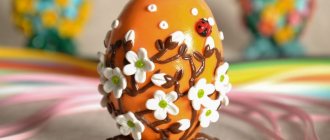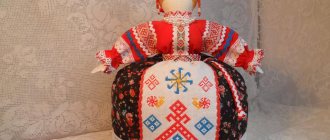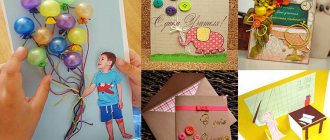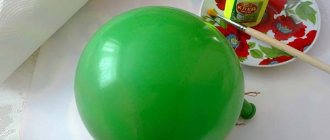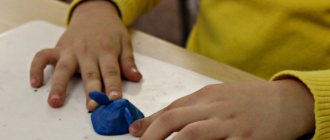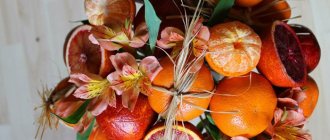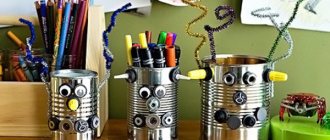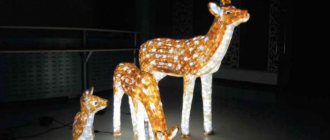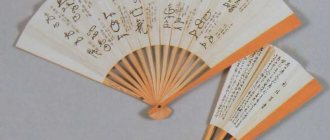Increasingly, you can find handmade dolls in homes. For those who are interested in making toys, a master class on making eyes will be useful.
In a store where it would seem you can buy eyes for crafts, it is difficult to find a finished part. The work doesn't take much time.
Plastic spoons
The easiest way to make eyes is to use oval scoops from disposable plastic spoons. This item is suitable for a large soft toy and a large doll.
The work doesn't take much time. The surface of the oval part of the spoon is sanded, which will enhance the adhesion of acrylic paint.
The part is mounted on double-sided tape and is used to attach it to the surface of the cardboard. Future eyes are ready to be decorated with acrylic paints.
The first layer is a white tone. Next, green or blue outlines of the irises are depicted.
The pupils and the outline of the iris are painted in black. White paint is used for the highlights, and flesh-colored paint is used for the eyelids. The work is done.
How to draw eyes on a doll? Homemade dolls: master class
Homemade textile dolls are not suitable as toys for small children. Young ladies who are already quite old usually become interested in them. And no wonder - fragile elegant dolls are easy to stain or tear during active play. Such toys are not washable due to a special manufacturing technology, which includes tinting, scenting and coating doll faces with acrylic paints.
In addition, handmade textile dolls are always decorated with many small details - buttons, flowers and other elegant things. Such a toy will be a wonderful gift for any girl or young woman and will serve as an interior decoration.
Many beginning needlewomen come up with the idea of creating a textile doll with their own hands. You should know that the huge variety of these toys comes down to a few specific options, each of which requires a different level of skill. Let's take a quick look at the most popular ones.
Homemade dolls and their varieties
The Tilde doll was invented by a Norwegian designer. Surely everyone has encountered this unusual creature with disproportionately long arms and legs, dots like eyes and a tiny head with rosy cheeks.
In addition, a variety of little animals, as well as accessories, handbags and cosmetic bags are made in the style of tilde dolls. This doll is the best option for a beginner in toy making. After all, its pattern is quite simple, and there are a great many master classes.
Pumpkinheads
Another option for dolls is a pumpkin head. Sewing it is more difficult. The main difference from the tilde is in the shape of the head, which is assembled from five wedges and its shape resembles a tiny pumpkin. The nose - sharp and neat - is the junction of all the wedges and protrudes slightly forward.
The doll's round face leaves room for the craftswoman's imagination to fly. All his features are drawn with thin lines, then painted with acrylic paints, sometimes funny details are added in the form of strands of hair or entire wigs, hats, freckles, and so on. Based on such a pattern, it is possible to create a huge number of options for textile designer dolls.
Other types
The Snowball doll can be distinguished by its large, stable legs, the feet of which are reinforced. Eyes can be either painted or in the form of dots. This toy stands firmly on the surface thanks to the dense padding of the legs.
Other handmade textile dolls can be made in a deliberately primitive style - with a touch of negligence and some old age. The effect is created as if this doll had been lying in a dusty attic for many years. The model name is appropriate - attic doll.
The patterns of such toys have a simplified form; it is not necessary to process the sections; the shabby look is achieved by tinting with appropriate paints. The initial impression of careless, hasty work disappears upon closer examination, when it becomes clear that the design of the doll's appearance has been thought out more than carefully.
Let's start from the head
The head of a textile doll is the most complex part of the product. To make it, craftswomen stock up on flesh-colored fabric or knitwear, wire, soft filler, as well as auxiliary materials - needles, adhesive plaster, buttons, glue, tufts of eyelashes and, of course, paints. How to draw eyes on a doll is not the easiest question. This is quite a complex job that requires some skills, as well as a fair amount of accuracy and patience.
Patterns for a doll’s head, as well as the entire product, can be easily found in abundance today both in magazines and on the Internet. In our article we will talk about painting the face of such a doll. And even more precisely, about how to make her eyes.
Drawing the mirror of the soul
How to draw expressive eyes for a textile doll? Often the contours of the toy's future facial features are marked with a pencil or a disappearing marker. Then, using special threads (you can take transparent monofilament) and a large needle, the features are tightened.
Correctly and successfully drawn eyes can capture a toy’s characteristic mood. A lively look will give the doll a unique charm and make it unique. If you treat the matter carelessly, you can ruin the impression of even the most neat craft.
Note for beginners
Before you paint the eyes of a textile doll with acrylic paints, you should familiarize yourself with the rules for depicting drawn fairy tale characters (not only people, but also funny animals). Most beginning craftswomen, when starting to draw this detail, experience some difficulties. They are afraid to take on such delicate work; they do not have the skills of such drawing and are often afraid of ruining the results of previous work.
Therefore, you should learn some secrets of successful work. Before starting painting, it is best to prime both the face and body of the doll with a mixture of water and PVA glue in equal proportions with the addition of flesh-colored acrylic paint.
Other tips for beginners
It’s worth practicing drawing a doll’s face on a separate sheet of paper. Such a draft will allow you to improve your skills and serve as a kind of cheat sheet during the main work. If you spoil even a few sheets, it doesn’t matter. But hone your skill, and the finished doll will not suffer.
For a sample, you can take a special magazine for needlewomen or for young mothers with babies; there you can find a master class on dolls of any type with many interesting good quality photographs.
Try to additionally prime your face with PVC glue, which can be practically undiluted, then dry thoroughly. After such a primer, the face looks porcelain and the paint adheres to it just fine. Using a glue-coated brush, go well along the seams on the neck that secure the head. After this, the doll’s neck acquires additional strength.
When working, excess paint should be removed from the brush by rubbing it over the paper, and the brush itself should be washed. You need to dip the tip into the paint very shallowly, literally a millimeter or two.
How to draw eyes on a doll: small technological secrets
To keep your hand from shaking and move confidently, your elbow should be rested firmly on the table. If after washing the brush there is still a small bluish mark on the paper, use this to apply additional light shadows under the eyelid, nose, etc.
It is better to choose synthetic paints; they have increased elasticity compared to natural ones. The instrument should be washed thoroughly, as acrylic dries very quickly and lumps form on the tips.
Before each set of paint, dry the brush by running it over the paper. If you dip it in acrylic not dry, but wet, the colors will turn out blurry and faded. But if the brush does not glide at all, you should still add water.
If any flaws or extra lines are found, the paint can be easily washed off with plain water using a cotton swab while it is fresh. When it has had time to dry, you will have to use a nail polish remover.
Do you need eyes?
It’s not for nothing that the eyes are called the mirror of the soul. This is immediately visible even in relation to dolls! Perhaps the tilde doll with its unique appearance can be left practically without a face, indicating the eyes with dots. In other cases, it is necessary to paint the doll’s eyes with paints. Without this, the craft will not acquire a soul and its own unique personality.
The image of a textile doll is always slightly naive, cheerful and somewhat surprised. Her facial features - a snub nose, a mouth with a wide smile - are usually drawn along the contour in advance. The artist’s job then is only to apply makeup.
To paint a doll's face, acrylic paints are most often used. The palette in which the paint will be diluted, as well as brushes of different hardness and thickness, should be prepared in advance, as well as the above-mentioned sheet of white paper for test strokes.
The doll's face is primed with paint in a tone slightly darker than the skin, using small, light strokes. Uniformity is achieved by shading the strokes with a cotton swab. Then white paint is applied to the stitched circles representing the eyes. Using a sharp pencil, mark the middle of each eye.
From each center they retreat upward a couple of millimeters, and dots are placed again. Circles of large diameter are drawn around them. Then new points are selected 1-2 millimeters higher, and other smaller circles are drawn with the center at them.
And then?
Try to make the eyes the same. The larger circles are first painted light brown. Without waiting for the paint to dry, draw a dark brown line along the diameter of each large circle and smoothly shade it towards the center. Near the small circle the color remains light brown.
This is the iris of the eye. It can be, at the master’s choice, blue or green. When the brown paint is completely dry, the pupil (small inner circle) should be filled with black.
A pair of white spots, smaller and larger, are placed on each pupil with a thin brush. And our doll’s eyes immediately acquire a vibrant sparkle! To match the eyes, you can slightly tint the toy’s lips with dry paint of a bright shade, and tint the skin with a mixture of instant coffee and ground cinnamon.
Let's start with the outlines
How to draw the eyes of a doll if their contours are not marked in advance? In this case, our master class will begin with drawing the facial features of the toy with a pencil. This should not be done haphazardly, but observing certain proportions.
Imagine your face in the form of a circle, mentally divide it into 4 sectors of the same size. The horizontal axis passes through the points where the centers of each of the pupils will be located, as well as the inner corners of the doll's eyes.
Depending on the chosen plastic surgery of the doll’s face, the outer corners of the eyes can be lowered below or raised above the line. In some cases they may turn out to be asymmetrical. For example, if our doll is melancholic, the corners should be lowered down and the eyebrows should be slightly raised.
Master class: continuation
Having outlined the pupils, we draw light contours of the doll’s features. Paint the whites with white paint using gentle movements. In the center of each eye we draw a couple of dots with bright blue or cyan paint. After drying, place a neat black circle inside, positioning it so that it touches the upper eyelid.
The highlights, as in the first case, are applied in the form of a pair of white dots. Then you need to shade a little dry white paint over the blue or dark blue iris. Moreover, try to maintain symmetry so that the doll’s eyes are the same. Dry pastels are also used for applying shadows. A blue tint is taken along the edges of the whites, and black along the contour of the eyelids.
At the final stage, the eyelashes are drawn, and then the contours of the doll’s nose and lips. The blush on the cheeks is applied with soft pastels or dry paint. You can add freckles.
Eyes like real ones
Some artists know how to draw the eyes of a doll with a live effect; they look not like they were drawn, but at least like glass. How to achieve this?
It should be remembered that each eye is a sphere placed in the doll's head. The location of the shadows corresponds to the geometry of this sphere. The lightest point will be the highlight, surrounded by light, penumbra and shadow.
To start working, as in the previous case, we draw the central axis in the middle of the height of the face. An inexperienced artist may feel that the eyes should be placed a little higher, closer to the hair. In fact, this impression is deceptive. This effect occurs due to the congestion of the lower part of the face with small details (mouth, nose, chin).
Let's start a difficult task
Inside the contour of each of the circles at the top and bottom we denote the eyelids. The top one should slightly cover the pupil. If it is drawn in the middle of the eye and does not touch the eyelid, the look will be ugly and frightened.
The brow ridges should be tinted. That is, darken the distance from the eye to the eyebrow a little to give the look volume and depth.
The eyes are painted over with light paint, but not completely white. This is done in order to subsequently highlight a bright white highlight against their background.
Let's continue drawing
Fill the iris with blue or brown. Pure colors are not recommended; it is better to mix them. Do not forget, as in previous cases, to change the depth of tone, decreasing towards the pupil.
Then we designate shadows under the eyelids. Around the centers of the pupils we place a pair of white dots. The lower one is a highlight, the upper one is its reflection. Then we further draw the eyelids, and the upper ones should be drawn brighter and clearer, and the lower ones should be lighter and lighter, with a slight darkening of the outer corners.
Finally, we tint the eyelids along with the nose and lips, visually adding volume. A wonderful effect will be obtained if you glue real eyelashes on the doll.
How to draw eyes on a pumpkin head doll
What should you take for work? The set of tools is almost the same, consisting of acrylic paints, dry pastels, a simple pencil and, of course, thin brushes for painting. The blank for the head of the future toy must be primed in advance with PVC glue and acrylic paint.
According to the scheme described earlier, the contours of facial features are drawn with a pencil. The area of each eye is painted over with white acrylic. The operation is repeated two or three times, due to which an increased density of the layer is achieved. Each layer must be thoroughly dried before applying the next; moisture can be removed with a hairdryer.
Shutdown
Then the iris is drawn and the pupils are designated. Blue acrylic paint should be slightly diluted with water. Both the iris and the pupil are painted over entirely. After drying, the pupils are indicated in black, the white points of glare are placed on the very border of it and the iris. Then part of it (the iris) should be highlighted. The best way to do this is to slightly dilute white acrylic in water and pick up a small amount of it on the tip of a thin brush.
After waiting for it to dry, we outline each of the eyes with a dark brown color, then carefully draw the line of the eyelids with it. Then you should depict the shadow that falls from the eyelids onto the eyes. To do this, we take a tiny drop of paint in two colors - black and blue. Mix them and dilute slightly with water. Place a little of the resulting mixture on the tip of a thin brush and carefully apply it under each eyelid.
Black eyeliner is placed on the space just under the eyelids. Then, for greater expressiveness, the eyes should be shaded using dry pastels. It would be best to apply it in small strokes and then gently blend it with a cotton swab.
Now we have completed the most labor-intensive part of the work. There is little left - we draw eyelashes and eyebrows for our toy, paint over the mouth. Don’t forget about blush, you can also add freckles - the doll’s face will immediately acquire a cute, perky expression.
fb.ru
Felt
The photo shows how felt is an excellent material for making eyes for crafts. These details are used to complete the look of handmade dolls.
You need to stock up on: a piece of felt, cardboard, Moment adhesive base, small scissors, a simple pencil.
The desired eye shape is drawn on cardboard - this will be one cardboard template. The inside of the eye is drawn in a smaller size - this is the second template.
Eye stencils for crafts are cut out along the contour. A pupil is cut out on one of the templates. A blank is cut out of white felt to form the shape of an eye along the contour of a large template.
Using the dimensions of a smaller template made of green or blue felt, the inner part of the eye is formed for crafts. Two felt parts are connected to each other with glue.
Contours are drawn with a black felt-tip pen. The eyelashes are glued “instantly”. The work is done.
Yarn and glue
You can quickly and easily make a part using yarn and glue. You don't need a lot of thread. A strand of yarn is laid out in a spiral to form a circle. This is the base of the eye.
There is a small black circle on top. Everything is covered with a drop of Moment glue. It is suitable for work because of its transparency. Leave to dry. The last step is to remove the excess strands of yarn with scissors.
Buttons and fabric
Round or oval buttons are also used to make eyes for crafts. The design is done with acrylic paints. Beads are painted using the same principle.
Craft flag - how to make it with your own hands correctly? Master class on making for holidays and parades (105 photos)- Craft angel - 105 photo ideas on how to make your own angel quickly and easily from scrap materials
Crafts from matches - 125 photos of original ideas for professionals and simple crafts for beginners
To make the eyes, leather and fabric are used according to the method of working with felt.
Paper and glass stones
Volumetric eyes for handmade crafts are made of paper and glass stones.
A paper blank of the iris is made. The desired color is selected. Before you print out eye irises for crafts, you need to make sure that the diameter of the workpiece will not be larger than the glass stone.
Decoupage glue is applied to the flat part of the stone. The iris blank is applied with the front side to the surface of the stone with glue. Leave until dry.
It is important to use decoupage glue when working. It will not affect the transparency of the stone and will not distort the design.
Crafts with children: a review of interesting and exciting ideas for creating toys and decorations (115 photos)- Crafts from tights: 60 photos of basic ideas and sewing original crafts with your own hands
Road-themed crafts - teaching children traffic rules and a review of the best road-themed crafts (150 photos)
A thin layer of glue is again applied to the dried surface. Threads of yarn are laid out on it, everything is covered with a white sheet.
You need to press it onto the paper with your finger so that everything sticks well. It takes some time to dry.
Excess paper and threads are cut off along the contour of the stone. You can use the eye blank for crafts.
DIY glass eyes for toys. We do custom painting
Today I will show you how I make eyes for my toys. My toys are felted, pure wool. But such eyes are suitable for both knitted and sewn toys. I don’t pretend to know the only correct way to make a painting, I’m just offering one of the options on how to create interesting eyes for your toys or dolls. The key word is copyright. Author's work, in one copy. After all, an exact repetition is impossible. So, if you're ready, let's get started! What you will need for work: You can see the brushes that I choose for work in the photographs. Three brushes from a salon that sells everything for nail design. Yes These brushes are very convenient, as they are thin and make perfect lines. Indispensable for small parts.
Three brushes from a salon that sells everything for nail design. Yes These brushes are very convenient, as they are thin and make perfect lines. Indispensable for small parts.
I also love my brushes from the art salon. I usually can’t do without them either. By the way, I prefer synthetics. In the photo, brush numbers (from top to bottom): No. 9, No. 5, No. 0. Of course, we need glass blanks for our work. I have cabochons - hemispheres in the shape of a circle.
Cosmetic sponges. This is almost the main character. I have makeup sponges from Avon, but it is not necessary to use these particular ones. You can even try working with regular sponges. The main thing is that they are sufficiently elastic with a dense surface.
This is almost the main character. I have makeup sponges from Avon, but it is not necessary to use these particular ones. You can even try working with regular sponges. The main thing is that they are sufficiently elastic with a dense surface.
The paints I use: In order to diversify the color palette, I also add acrylic. Paints with a metallic effect perform well on glass. I use acrylic paints: silver and gold. Making the pupil smooth and neat is very important! And since I’m still a “cranky guy,” I resort to the help of this miracle thing called the “officer’s ruler.”
You also need to have a palette on hand (I use a regular transparent file) and a couple of cotton pads to blot the brush, removing excess water. Glass paint and acrylic do not like water very much, so get used to working with an almost dry brush.
That is, I always start with the pupil. The rest of the colors follow. And an important point in working with a hemisphere. Remember that this is a very magnifying lens! Therefore, make the pupil a little smaller. Draw it on paper and place the cabochon on top. You will immediately understand whether you are in the right size or not.
Next, I advise you to turn on the video, in which I tell in detail and show how to work with a glass hemisphere and how exactly to achieve the most effective result. .
Thank you for your attention! I hope that my master class was useful for you. I have a huge request to those who are going to take my advice into service. If it’s not difficult for you, post at least a couple of photos of what you ended up with. I'm very interested to see! Good luck to everyone and more creative ideas  Be creative.
Be creative.
Clay
Flat eyes are made from polymer clay. The material is rolled out and the desired eye shape is squeezed out of it. The parts are baked. Later they are painted with acrylic paints.
Before making eyes for crafts in volume, the clay is formed into balls and divided in half. Next, the material is baked and the iris is painted, and a black pupil is applied.
How to draw eyes for dolls on glass – Fair of Masters
Many people are faced with the fact that it is not so easy to find eyes that are suitable in size, color and type for their creation. When I had to face this, I decided: shouldn’t I make my own eyes?
I’ll warn you right away: this type of eyes is suitable mainly for sculpted creatures, although perhaps someone can figure out how to use them in sewn toys.
So let's get started.
To create the eyes we will need:
1. Glasses (in any pet store you can find them in the aquarium section).
2. Brushes (you can get by with one, but you can take thinner and thicker ones).
3. Acrylic paints.
4. Palette and some water.
I specifically choose several different shades of the same color to make the eye look more natural and beautiful.
It is necessary to remember that when working with glass you will have to apply the paint in the reverse order, and if usually a dark color is applied first, and then the highlights and veins are lighter, then here we start with the light veins and pupil.
The first coat of paint always turns out translucent. In the iris of the eye this is good, but the pupil must be deep.
To draw the pupil, you need to place a dot approximately in the middle, and then gradually expand it with a brush.
After the first layer of paint dries and we are convinced that both pupils are the same size, we can apply the second layer: not sparing the acrylic.
Since I plan to make two toys in the near future, I’m making two pairs of eyes: a cat’s and a regular one.
After the pupil is dry, I begin to apply the iris.
The most important thing is to move the brush from the center to the edges and not be afraid to leave thick strokes of paint.
I have this paint with a mother-of-pearl effect and it gives a very interesting shine to the look. It's optional and you can just use any light base paint.
After the base paint dries, I squeeze a little acrylic onto the paper, in accordance with my ideas. The cat's eye will be green-yellow. The second pair is blue.
For cat eyes I use green and two shades of yellow:
The green in a cat's eyes is usually only around the pupil. Therefore, with thick strokes I paint over the area around the black.
I wait for the paint to dry and apply lemon paint:
I wait again and after that I finish with a darker base coat, which I don’t regret.
The main thing is to make sure that your previous layers are dry.
At this point, I put the cat’s eyes aside and squeeze out shades of blue, blue paint and silver onto the palette:
I make veins from blue. Also - from the center to the edges, with a thin brush, but not transparently, but so that the paint is visible:
Adding silver:
And, after these three layers of paint have dried, I finish:
Now all we have to do is wait for everything to dry and turn it over to see what we got.
And the result was cat eyes:
And not felines 
And an example of using such eyes in my toys:
www.livemaster.ru
Eyes for garden crafts
For garden crafts, plastic lids are used, which are decorated with paints.
You must first cut out the shape of the eyes from foam plastic, and only then apply the entire design. But since garden crafts are left outside for the winter, the old eyes will need to be replaced with new ones in the spring.
It is possible to make decorative eyes for crafts in different ways using available materials and imagination.
Eye expression
Sometimes it’s hard to imagine how to make eyes for a knitted doll and at the same time give her a special expression. A lot depends not only on the shape of the eye, but also on the knitted highlight inside the iris and the eyebrow above the eye itself.
You might be interested in Popular options for restoring slimes at home
A round eye without an upper eyelid will give the toy surprise or fear; if the eyebrows are a house, it will look very cute and naive.
A squinted eyelid with dropped eyebrows towards the nose will show an angry or dissatisfied emotion. Closed eyes with raised eyebrows will give the feeling that the toy is having pleasant dreams. It all depends on the imagination of the master himself.
Doll's emotions
Photo of a peephole for crafts
Read here - Craft robot: diagrams and step-by-step description of making a robot with your own hands (125 photos and videos)
Did you like the article?
0

